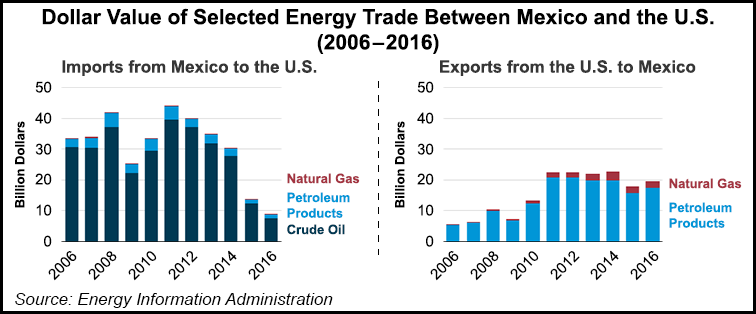Markets | E&P | Mexico | NGI All News Access | NGI The Weekly Gas Market Report
U.S.-Mexico NatGas Exports Running 4.2 Bcf/d This Year, EIA Says
Energy trade between the United States and Mexico continues to grow while the value of U.S. exports has surpassed the value of what it imports from Mexico, according to the U.S. Energy Information Administration (EIA). Meanwhile, exports of U.S. natural gas to Mexico so far this year have exceeded 4.2 Bcf/d, the agency said Thursday.

However, border tax policies that could emerge from the Trump administration could undo some of the gains enjoyed by U.S. gas producers if Mexico were to reciprocate with its own border tax, warned analysts at Bank of America Merrill Lynch (BofAML) in a note published last Friday.
Pipeline shipments dominate U.S.-Mexico gas trade, EIA said in a note on its website. U.S. gas exports were nearly 2.9 Bcf/d in 2015, accounting for nearly 60% of U.S. gas exports. Through November of last year, U.S. exports to Mexico averaged 3.8 Bcf/d. According to reports, EIA said, daily flows this year are exceeding 4.2 Bcf/d.
“In 2017 and 2018, natural gas pipelines currently under construction or in the planning stages are expected to nearly double the pipeline natural gas exporting capacity from the United States to Mexico,” EIA said. “Much of this natural gas will likely be used to generate electricity as Mexico’s energy ministry expects to add significant natural gas-fired electricity generating capacity through 2029.”
But if a border tax on U.S. imports from Mexico were instituted by the Trump administration, Mexico might respond in kind, and that would be harmful for U.S. gas producers. “If the [U.S.] border tax as reciprocated by Mexico, sparking a wider trade war, it could severely hurt U.S. natgas exports and drive down prices at the Henry Hub,” BofAML said last week.
The United States sends 5% of its natural gas production to Mexico through pipelines, BofAML said. “With new pipeline export capacity coming up, the energy ties between the two countries are set to strengthen,” the bank said. It added that growing pipeline connectivity between the Marcellus Shale and the U.S.-Mexico border region will send more Northeast gas to Mexico, but it could transmit border tax pain to the Northeast.
Bilateral energy trade between the United States and Mexico has evolved “significantly,” EIA said. “In 2015 and 2016, the value of U.S. energy exports to Mexico, including rapidly growing volumes of both petroleum products and natural gas, exceeded the value of U.S. energy imports from Mexico as volumes of Mexican crude oil sold in the United States continued to decline. For 2016, the value of U.S. energy exports to Mexico was $20.2 billion, while the value of U.S. energy imports from that country was $8.7 billion.”
© 2024 Natural Gas Intelligence. All rights reserved.
ISSN © 1532-1231 | ISSN © 2577-9877 | ISSN © 1532-1266 |
